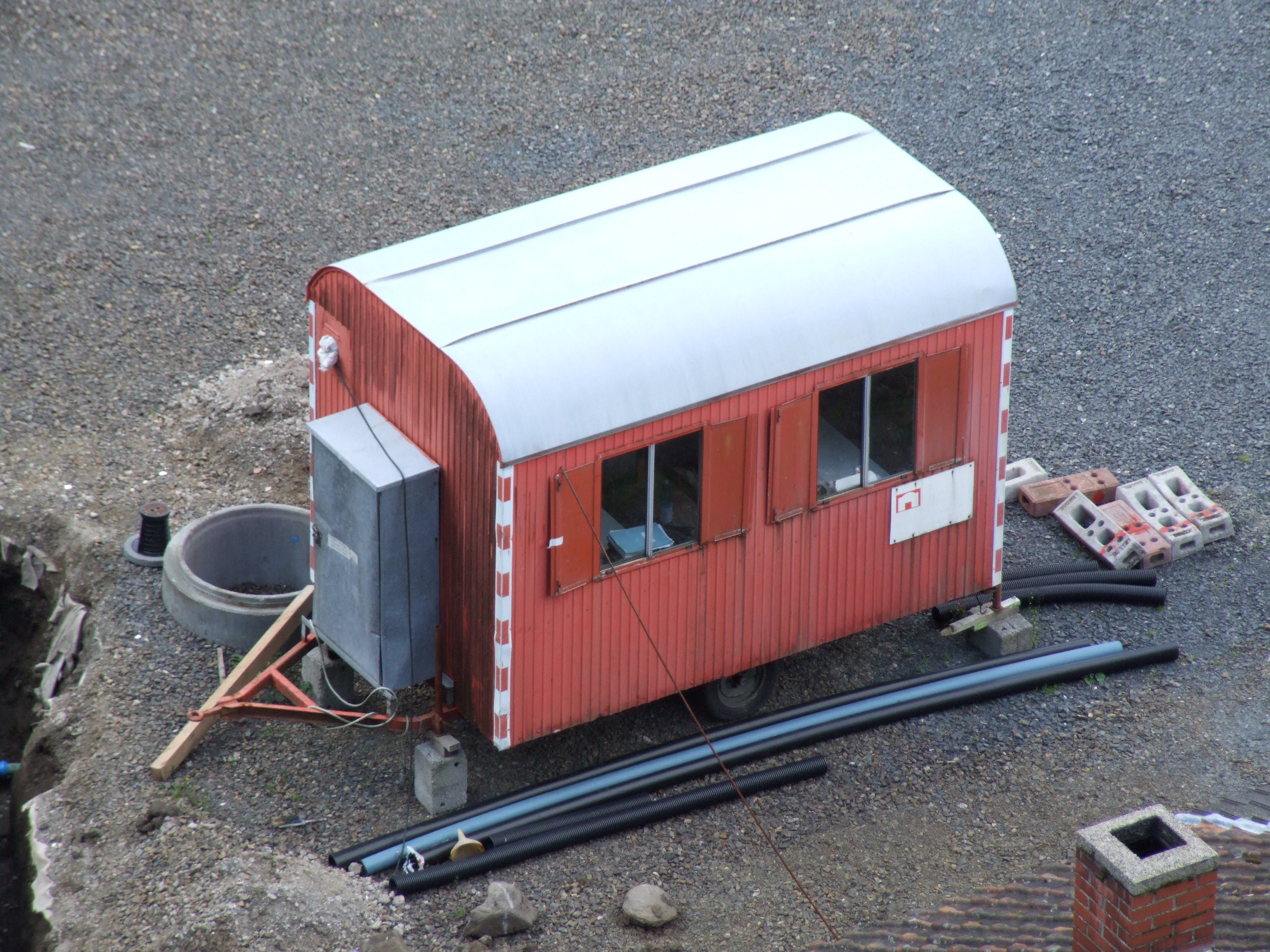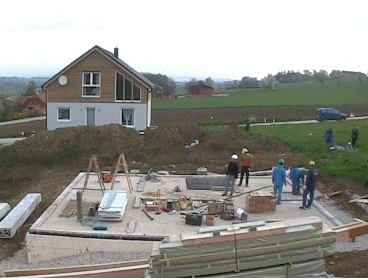|
MAN Steel House
The MAN steel house was a pre-fabricated building by MAN SE, MAN (Machine Works Augsburg-Nuremberg, Nürnberg). A total of 230 units were built worldwide from 1948 to 1953. History The MAN factory in Ginsheim-Gustavsburg, looking for new non-military markets after World War II built from 1948 prefabricated steel houses, based on a concept from the 1920s. The concept was developed in the headquarters in Augsburg based on an idea of the engineer Heinz Bauer and was commercially produced in Mainz-Gustavsburg.Enrico SantifallerHighlights – Mittelrhein.(PDF; 2,7 MB) MAN built a sample estate, which once housed the senior staff, close to the Cramer-Klett-settlement of Gustavsburg, which had been built in the style of a garden city in the first quarter of the 20th century. Two different models were presented there, to export them on a large scale worldwide. The model home complex showed the basic type with a base of . Production was however discontinued after production of 230 ... [...More Info...] [...Related Items...] OR: [Wikipedia] [Google] [Baidu] |
Augsburg Sebastianstr 29d
Augsburg (; bar , Augschburg , links=https://en.wikipedia.org/wiki/Swabian_German , label=Swabian German, , ) is a city in Swabia, Bavaria, Germany, around west of Bavarian capital Munich. It is a College town, university town and regional seat of the ''Regierungsbezirk'' Swabia (administrative region), Schwaben with an impressive Altstadt (historical city centre). Augsburg is an Urban districts of Germany, urban district and home to the institutions of the Augsburg (district), Landkreis Augsburg. It is the third-largest city in Bavaria (after Munich and Nuremberg) with a population of 300,000 inhabitants, with 885,000 in its metropolitan area. After Neuss, Trier, Cologne and Xanten, Augsburg is one of Germany's oldest cities, founded in 15 BC by the Romans as Augsburg#Early history, Augusta Vindelicorum, named after the Roman emperor Augustus. It was a Free Imperial City from 1276 to 1803 and the home of the patrician (post-Roman Europe), patrician Fugger and Welser familie ... [...More Info...] [...Related Items...] OR: [Wikipedia] [Google] [Baidu] |
Deutschmark
The Deutsche Mark (; English: ''German mark''), abbreviated "DM" or "D-Mark" (), was the official currency of West Germany from 1948 until 1990 and later the unified Germany from 1990 until the adoption of the euro in 2002. In English, it was typically called the "Deutschmark" (). One Deutsche Mark was divided into 100 pfennigs. It was first issued under Allied occupation in 1948 to replace the Reichsmark and served as the Federal Republic of Germany's official currency from its founding the following year. On 31 December 1998, the Council of the European Union fixed the irrevocable exchange rate, effective 1 January 1999, for German mark to euros as DM 1.95583 = €1. In 1999, the Deutsche Mark was replaced by the euro; its coins and banknotes remained in circulation, defined in terms of euros, until the introduction of euro notes and coins on 1 January 2002. The Deutsche Mark ceased to be legal tender immediately upon the introduction of the euro—in contrast to the o ... [...More Info...] [...Related Items...] OR: [Wikipedia] [Google] [Baidu] |
Construction Trailer
Construction trailers are mobile structures (trailers) used to accommodate temporary offices, dining facilities and storage of building materials during construction projects. Hook-ups Typically, trailers need to be equipped with telephone lines and electrical power. Lavatories are usually provided for separately. They are often skid-mounted, on trailers, or put on piles. Construction trailers are often manufactured using traditional stick-frame construction. Intermodal containers are also being converted into construction trailers. Use in different countries United States Municipalities can require the use of construction trailers to be subject to permit proceedings. The City of Fremont, California, for example, publishes its permit requirements on its municipal website. Enclosed Cargo Trailers are a very popular tool used by many in the construction industry. Keeping equipment and materials clean and dry are a high priority to anyone in the construction industry. These trail ... [...More Info...] [...Related Items...] OR: [Wikipedia] [Google] [Baidu] |
Portable Classroom
A portable classroom (also known as a demountable or relocatable classroom, portables, bungalows), is a type of portable building installed at a school to temporarily and quickly provide additional classroom space where there is a shortage of capacity. They are designed so they may be removed once the capacity situation abates, whether by a permanent addition to the school, another school being opened in the area, or a reduction in student population. Such buildings would be installed much like a mobile home, with utilities often being attached to a main building to provide light and heat for the room. Portable classrooms may also be used if permanent classrooms are uninhabitable, such as after a fire or during a major refurbishment. Sometimes, the portable classrooms are meant to be long-lasting and are built as "portapacks". A portapack combines a series of portables and connects them with a hallway. Portapacks are usually separated from the main building but can connect to ... [...More Info...] [...Related Items...] OR: [Wikipedia] [Google] [Baidu] |
Prefabricated Building
A prefabricated building, informally a prefab, is a building that is manufactured and constructed using prefabrication. It consists of factory-made components or units that are transported and assembled on-site to form the complete building. History Buildings have been built in one place and reassembled in another throughout history. This was especially true for mobile activities, or for new settlements. Elmina Castle, the first slave fort in West Africa, was also the first European prefabricated building in Sub-saharan Africa. In North America, in 1624 one of the first buildings at Cape Ann was probably partially prefabricated, and was rapidly disassembled and moved at least once. John Rollo described in 1801 earlier use of portable hospital buildings in the West Indies. Possibly the first advertised prefab house was the "Manning cottage". A London carpenter, Henry Manning, constructed a house that was built in components, then shipped and assembled by British emigrants. Th ... [...More Info...] [...Related Items...] OR: [Wikipedia] [Google] [Baidu] |
Modular Building
A modular building is a prefabricated building that consists of repeated sections called modules. Modularity involves constructing sections away from the building site, then delivering them to the intended site. Installation of the prefabricated sections is completed on site. Prefabricated sections are sometimes placed using a crane (machine), crane. The modules can be placed side-by-side, end-to-end, or stacked, allowing for a variety of configurations and styles. After placement, the modules are joined together using inter-module connections, also known as inter-connections. The inter-connections tie the individual modules together to form the overall building structure. Uses Modular buildings may be used for long-term, temporary or permanent facilities, such as construction camps, schools and classrooms, civilian and military housing, and industrial facilities. Modular buildings are used in remote and rural areas where conventional construction may not be reasonable or pos ... [...More Info...] [...Related Items...] OR: [Wikipedia] [Google] [Baidu] |
Portacabin
A portable, demountable or transportable building is a building designed and built to be movable rather than permanently located. Smaller version of portable buildings are also known as portable cabins. Portable cabins are prefabricated structures manufactured for uses such as site office, security cabin, accommodation, storage, toilets etc. Portable cabins are an affordable alternative to traditional buildings and are useful when accommodation is required for an uncertain period of time. From formal office accommodation to comfortable eating and relaxation areas, toilet and shower facilities to site security units portable cabins are fast to manufacture and easy to deliver. A common modern design is sometimes called a modular building but portable buildings can be different in that they are more often used temporarily and taken away later. Portable buildings (e.g. yurts) have been used since prehistoric times. Many modern types of portable buildings are designed so that they c ... [...More Info...] [...Related Items...] OR: [Wikipedia] [Google] [Baidu] |
Euro
The euro ( symbol: €; code: EUR) is the official currency of 19 out of the member states of the European Union (EU). This group of states is known as the eurozone or, officially, the euro area, and includes about 340 million citizens . The euro is divided into 100 cents. The currency is also used officially by the institutions of the European Union, by four European microstates that are not EU members, the British Overseas Territory of Akrotiri and Dhekelia, as well as unilaterally by Montenegro and Kosovo. Outside Europe, a number of special territories of EU members also use the euro as their currency. Additionally, over 200 million people worldwide use currencies pegged to the euro. As of 2013, the euro is the second-largest reserve currency as well as the second-most traded currency in the world after the United States dollar. , with more than €1.3 trillion in circulation, the euro has one of the highest combined values of banknotes and coins in c ... [...More Info...] [...Related Items...] OR: [Wikipedia] [Google] [Baidu] |
Pre-fabricated Building
A prefabricated building, informally a prefab, is a building that is manufactured and constructed using prefabrication. It consists of factory-made components or units that are transported and assembled on-site to form the complete building. History Buildings have been built in one place and reassembled in another throughout history. This was especially true for mobile activities, or for new settlements. Elmina Castle, the first slave fort in West Africa, was also the first European prefabricated building in Sub-saharan Africa. In North America, in 1624 one of the first buildings at Cape Ann was probably partially prefabricated, and was rapidly disassembled and moved at least once. John Rollo described in 1801 earlier use of portable hospital buildings in the West Indies. Possibly the first advertised prefab house was the "Manning cottage". A London carpenter, Henry Manning, constructed a house that was built in components, then shipped and assembled by British emigrants. Thi ... [...More Info...] [...Related Items...] OR: [Wikipedia] [Google] [Baidu] |







